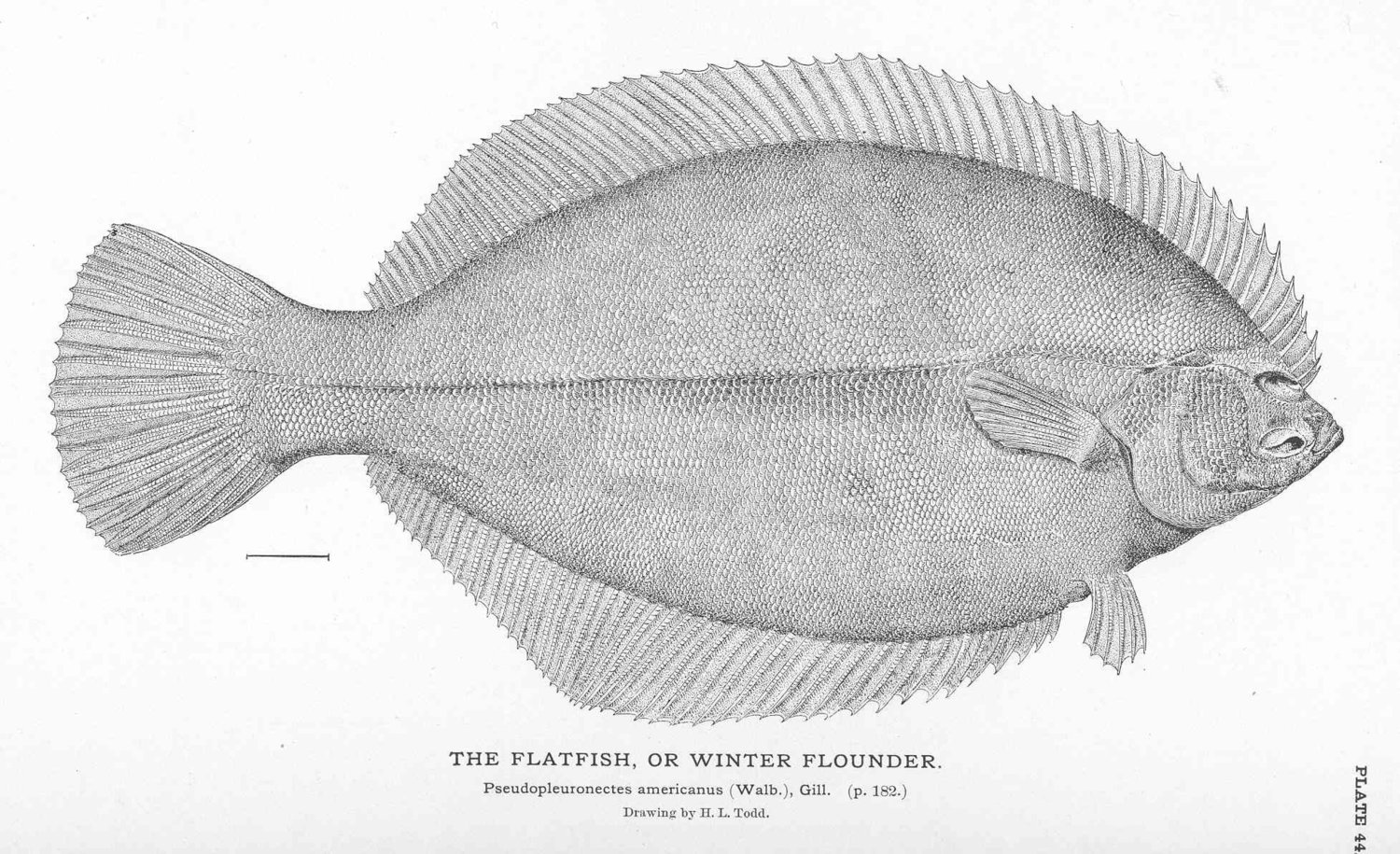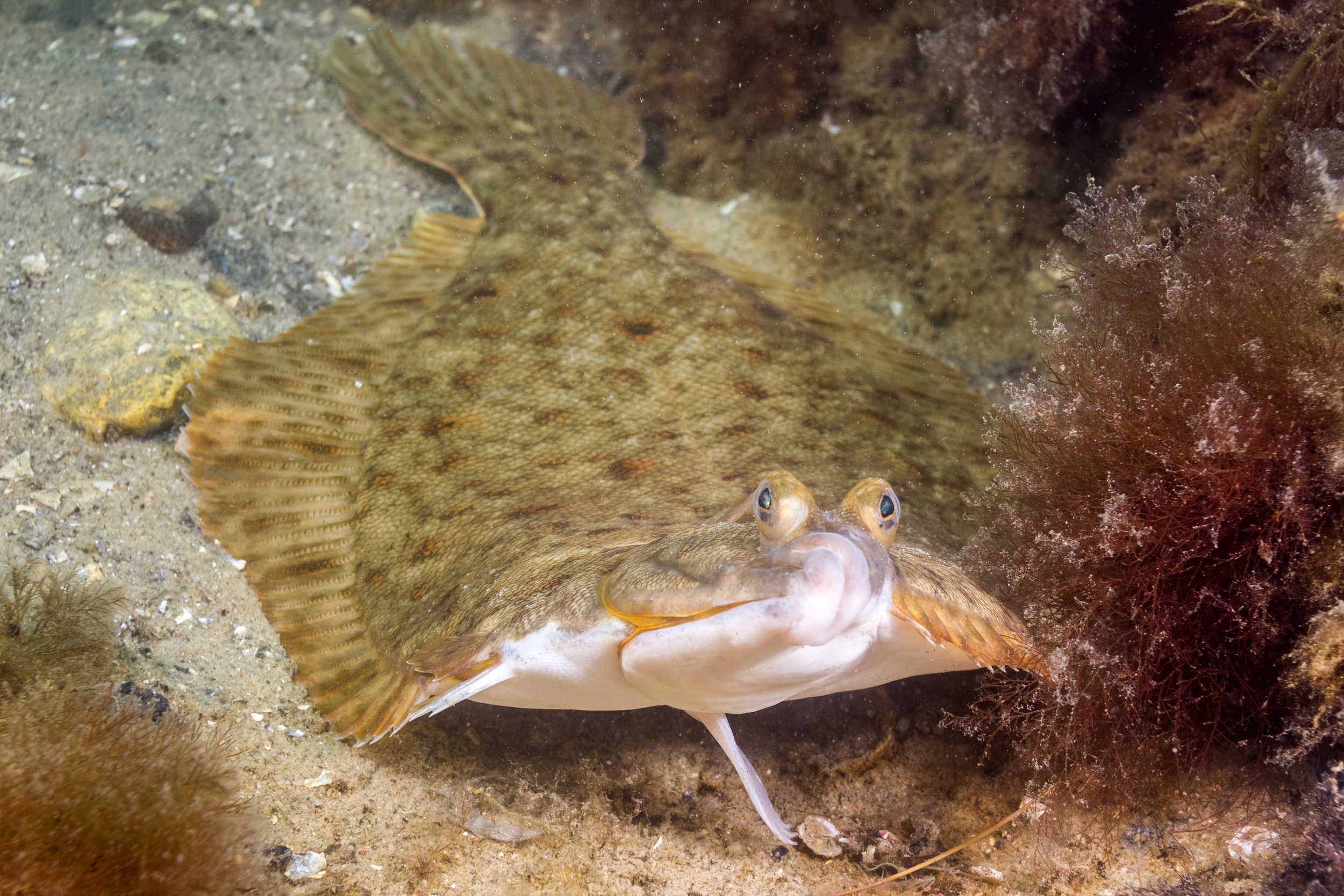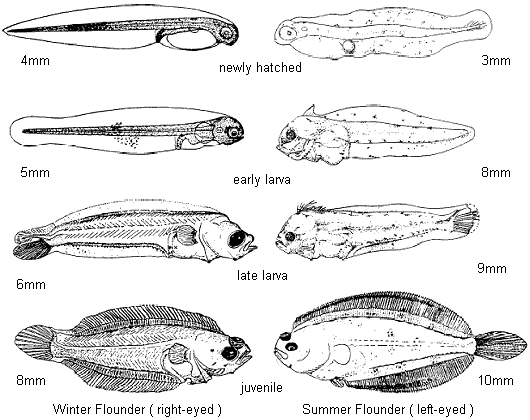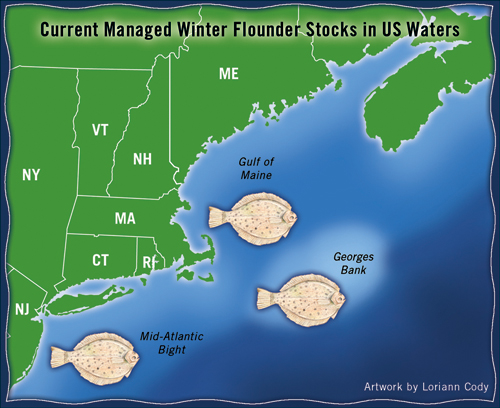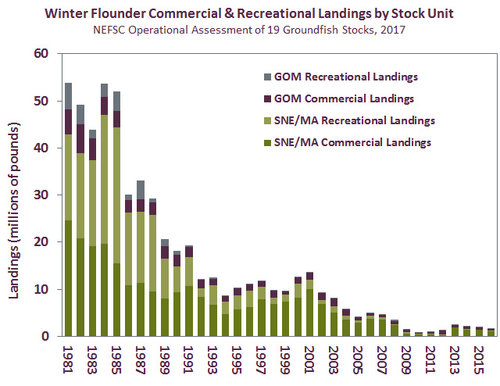WINTER FLOUNDER
Pseudopleuronectes americanus,
Can a cold loving fish continue to exist in urban-suburban waters and in an ever-warming world?
Winter flounder is also known as Flatfish, Blackback Flounder, Georges Bank Flounder, Rough Flounder, Flounder, Mud Dab, Sole, Gray Sole, or Lemon Sole. The many names suggest how popular and abundant this fish was at one time along the Northwest Atlantic for coastal people’s subsistence.
With a name like “winter flounder” or “Georges Bank flounder” (Georges Bank is a large shoal area located between Cape Cod, Massachusetts, and Cape Sable Island, Nova Scotia) it’s not difficult to figure out this fish loves cold water. Winter flounders are supreme cold-water fish. In fact, they not only thrive in cold water, this fish even spawns in cold water, when waters are normally ice-cold during the winter and spring, as early as December in North Carolina and as late as June in the Gulf of St. Lawrence, Canada.
These frigid conditions might sound foolish for any one fish to endure day in and day out until you realize the winter flounder for a long time has had evolution on their side. Spawning during the winter allows this flatfish to reproduce when few predators are around to bother, harass, or more importantly gobble up their eggs and young. One single female typically lays a half million eggs and the optimal water temperature range for their survival is 32 degrees to 50 degrees F. In contrast, striped bass, a large predatory fish, prefers a water temperature range from 55° F to 68° F and Bluefish, opportunistic predators that will feed voraciously on almost any prey they can capture including young fish, prefers warm waters above 58 degrees F.
This reproduction strategy for winter flounder is pure genius. They like it cold when lots of other fish do not. You would think with a limited number of predators to eat their eggs, the population of this flatfish would not only be healthy, but increasing. Yet, in many cases (though certainly not all), the winter flounder population is doing just the opposite, it’s in decline. Huh….what’s going on?
Please read below to find out more.
Winter Flounder is a small-mouthed, right-eyed ("dextral") flatfish of the family Pleuronectidae. The fish are found in estuaries and on the continental shelf of the Northwest Atlantic, from the Gulf of St. Lawrence, Canada to North Carolina. Winter flounder are most common in cold waters north of Delaware Bay.
Unlike many species of fish that prosper in warm waters and migrate when water temperatures start to dip below 55 degrees F, chilly water does not scare away winter flounder. It not only survives, it thrives in cold water.
Winter Flounder spawn in estuaries during the winter using the shallow waters of coves and bays as a nursery. The specie's ability to tolerate cold water, around freezing, is an evolutionary strategy that allows the fish to reproduce when few predators are active to endure.
A juvenile winter flounder found in Sandy Hook Bay, NJ
BUT HOW DOES THIS SMALL-MOUTHED FLATFISH SURVIVE IN COLD WATER, SOMETIMES WELL BELOW 32 DEGREES F?
NO JOKE, THE FISH SEEMS TO MANUFACTURE ITS OWN ANTIFREEZE.
Image of adult Winter flounder rom Adobe Stock.
Species of winter flounder have evolved in a remarkable way to tolerate the often frosty and frigid waters of eastern Canada, New England, and the Mid-Atlantic. Scientists Christopher B. Marshall, Avijit Chakrabartty, and Peter L. Davis in a 2005 article in the Journal of Biological Chemistry found that the fish have adapted to their cold-water environments due to the presence of “antifreeze” proteins (type I AFP) and other hyperactive antifreeze proteins in the plasma and bloodstream that are rich with amino acids, greater than 60 percent. These special proteins are capable of making a “freeze resistance” fish.
The acids bind to ice crystals to prevent the growth of pointed shapes in the bloodstream that can cause damage to internal organs, cells, and blood vessels. With cells and bodies composed mostly of water, the formation of ice crystals in the blood can lead to the irreversible damage to internal tissues. Unique chemical properties within the flat, egg-shaped body of a winter flounder help to make ice crystals grow in a more favored curved or round shape.
The combination of these acidic proteins work so well that winter flounder are able to survive in waters at 28.4 degrees F, the freezing point of seawater.
THIS EVOLUTIONARY INNOVATION IS NOT ONLY FOUND IN WINTER FLOUNDER, BUT IN OTHER FISH THAT SWIM IN COLD WATER ENVIRONMENTS, INCLUDING THE ANTARCTIC TOOTHFISH AND THE ARCTIC COD. SOME OVER-WINTERING INSECTS, SUCH AS BEETLES, HAVE ADDITIONALLY EVOLVED WITH THE ANTIFREEZE GENE TO SURVIVE COLD AND SNOW.
8mm long juvenile winter flounder fish with eyes that have recently migrated to one side of the face.
Spawning for winter flounder typically takes place in near-shore waters from winter to spring, with adults often returning to the same areas where they were born to spawn.
Drawing: New Jersey Scuba Diving
Females produce between 500,000 to 1.5 million eggs, which they deposit on sandy or muddy bottoms and algae mats at night. Nursery habitat for winter flounder larvae and juveniles is typically saltwater coves and protected embayments within the upper reaches of an estuary in early spring (although larvae and juveniles have also been found in open ocean areas such as Georges Bank and Nantucket shoals) and moving into the lower estuary later in the season.
After hatching, larvae have eyes on both sides of their head, just like any other fish. But in five to six weeks, the little flounders settle to the bottom of an estuary to begin a metamorphosis. After a few weeks, their left eye will migrate to the right side of their body, completing a transformation into a juvenile flounder or a true flatfish.
Winter flounders have small mouths, which limits the type of food they can eat.
Picture taken at Mystic Aquarium, CT
A single winter flounder can live up to 18 years, growing as big as 25 inches and weighing up to 8 pounds, though 1 to 3 pounds are more typical. Many factors influence larval and juvenile growth and survival, including temperature, salinity, dissolved oxygen, and food availability, such as small shrimps and zooplankton.
Winter flounder generally feed during the day as they depend on sight to locate prey. The diet of winter flounder is typical of a fish that is benthic or lives along the bottom, but their small mouths limit what they can eat. Winter flounder are ambush predators. Flounders will often lie in wait to feed on shrimps, amphipods, sandworms, small clams, and smaller fish. One of the winter flounder’s favorite foods are the siphon tip of Hard Clams (Mercenaria mercenaria).
Large fish, including striped bass, bluefish, summer flounder and winter skate prey on juvenile winter flounder. Atlantic cod, spiny dogfish, monkfish, bluefin tuna, ospreys, and seals prey on adults.
Winter flounder are masters of camouflage, changing from light to dark, depending on their environment to ambush prey and escape predators.
POPULATION STATUS
Picture: NY Sea Grant
The winter flounder population we experience today is just a small fraction of what it used to be, especially during the 1970s and early 1980s. Winter flounder once supported a massive recreational and commercial fishery along the northeast. The species started to decline around 1984, largely due to overfishing. Nowadays, winter flounder is a highly regulated aquatic species that is largely managed by the Atlantic States Marine Fisheries Commission (ASMFC).
In New Jersey, this popular flatfish was once fished from November and December after the fish migrated from their offshore feeding grounds. Today, due to a sharply diminished population, fishing for winter flounder is limited to just six or so weeks each spring. The situation is similar in nearby coastal states, except in Rhode Island where all of Narragansett Bay is closed to winter flounder fishing due to a severely reduced population.
There are three (3) management stocks of winter flounder in waters of the United States: 1. The Gulf of Maine, 2. Georges Bank, and 3. Southern New England/Mid-Atlantic.
Population levels for winter flounder seem stagnant or in decline in Southern New England and the Mid-Atlantic. The Georges Bank population (located between Cape Cod, Massachusetts, and Cape Sable Island, Nova Scotia), however, has been increasing since 2005 and is not subject to overfishing. The Gulf of Maine stock is the smallest of the three winter flounder stocks and scientists have been unable to determine a current estimate for the winter flounder stock in the Gulf of Maine.
Winter flounder is managed as three stocks; Georges Bank (GBK), Gulf of Maine (GOM), and Southern New England/Mid-Atlantic (SNE/MA). Recreational landings peaked in 1982 at 16.4 million pounds and have since maintained a declining trend. In 2016, recreational harvest in SNE and GOM was 72,765 pounds and 52,920 pounds, respectively. Chart courtesy of ASMFS
Chart courtesy of ASMFS
The reasons for the decline of winter flounder in Southern New England and the Mid-Atlantic region are many and unclear, but global warming and water pollution almost certainly have parts to play. Jason McNamee, chief of marine resource management for the Rhode Island Department of Environmental Management, suggests that many young fish are not surviving to adulthood. It could be lower amounts of dissolved oxygen in the water due to polluted water from too many nutrients entering waterways as runoff, made worse by warmer waters. Surface waters in Narragansett Bay increased between 2.5 and 2.9 degrees Fahrenheit between 1960 and 2012. McNamee also states that another reason might be from predators expanding their seasonal reach due to the lack of long-term ice forming in estuaries during the wintertime from an increase in air temperatures possibly caused by the effects of global warming.
According to the classic ichthyologist book, Fishes of the Gulf of Maine, edited by Bruce B. Collette and Grace Klein-MacPhee (Third Edition 2002), winter flounder can for short periods of time avoid warm water conditions by burying themselves in the sand at the bottom of a bay. However, if warm water conditions persist and the fish are unable to swim away from warm “shallow enclosed bays they can perish by the thousands during spells of very hot summer weather, as happened in Moriches Bay, Long Island in 1917 when temperatures rose to about 30 degrees C (86 degrees F).”
Is there a future for a beloved flatfish that loves cold water in an ever-warming world?
Winter flounder (Pseudopleuronectes americanus) in Narragansett Bay. Credit: Jerry Prezioso, NEFSC/NOAA

